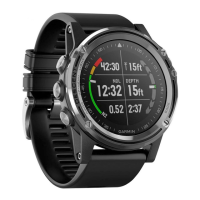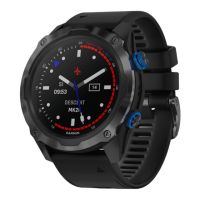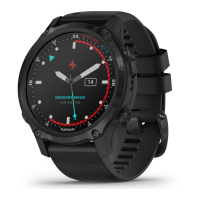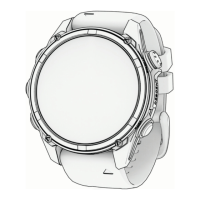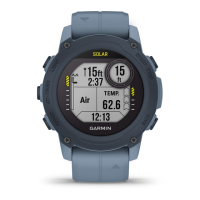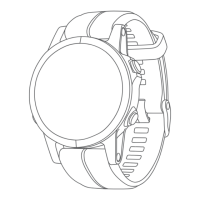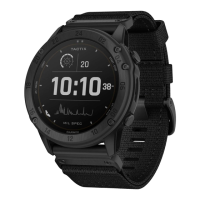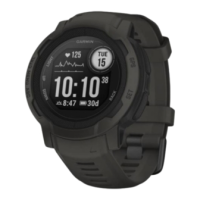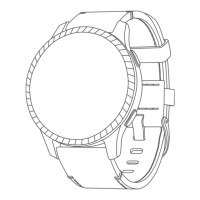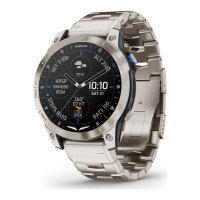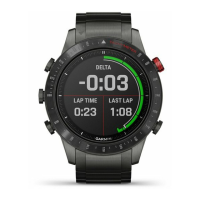Do you have a question about the Garmin DESCENT MK2 and is the answer not in the manual?
Steps to set up the watch and learn basic features.
Accessing quick functions like Do Not Disturb, saving location, turning off.
Important safety warnings and precautions for using the device while diving.
Steps to start any activity on the device.
Use the triathlon activity to transition between sports segments.
Definitions of swimming terms like length, interval, stroke, and swolf.
Steps to start and play a round of golf using the device.
Details displayed for the current hole, including distances and par.
Record routes and statistics for indoor climbing activities.
How to enable and configure notifications from a paired smartphone.
View detailed fitness and activity information.
Detects incidents during activities and sends alerts to emergency contacts.
Connect the device to a Wi-Fi network.
Download custom watch faces, data fields, widgets, and device apps.
Add credit or debit cards to your Garmin Pay wallet.
How to make payments using your watch at a reader.
Connect to music providers via the Garmin Connect app.
Details on wearing the device for accurate wrist-based heart rate readings.
Tips to improve accuracy or resolve erratic heart rate data.
How to use running dynamics accessories and view data screens.
Explanation of VO2 max. and how the device estimates it.
Intensity at which lactic acid accumulates, indicating fatigue.
Steps to get an accurate VO2 max. estimate for running activities.
View HRV and stress level using a chest heart rate monitor.
Guided test to estimate lactate threshold using a chest heart rate monitor.
Shows how training affects fitness and performance.
Displays time remaining until full recovery.
How environmental factors impact training and performance.
How to view your estimated recovery time.
Displays current Body Battery level and historical graphs.
How to manually begin a pulse oximeter reading.
Update user profile for accurate training data calculation.
How to set default and custom heart rate zones.
Turn off alerts and notifications for uninterrupted sleep or focus.
Download and follow workouts from Garmin Connect.
Create interval workouts based on distance or time.
Download PacePro plans from Garmin Connect.
Race segments and compare performance with others.
Track and view personal bests for activities.
Set multiple alarms with specified times.
Set and save countdown timers or use a quick timer.
Save your current location to navigate back to it later.
Create a new location by projecting distance and bearing from current location.
View map data including topographical contours and points of interest.
Manually calibrate the compass sensor outdoors for accuracy.
Manually calibrate the barometric altimeter using GPS or DEM.
Analyze time spent in different heart rate zones.
Customize data pages, alerts, and training features for each activity.
Add the map to the data screens loop for an activity.
Mark laps automatically at specific distances.
GPS setting that records track points less frequently to increase battery life.
Display and analyze Body Battery levels.
Display current and average resting heart rate.
Display sleep statistics like total sleep time and sleep stages.
Control your inReach device using your Descent device.
Control VIRB camera during an activity.
Manually calibrate the compass sensor outdoors for accuracy.
Manually calibrate the barometric altimeter using GPS or DEM.
Manually calibrate the barometer using elevation or sea level pressure.
Change map theme for optimized data display.
Set alerts to help navigate to your destination.
Reset all device settings to factory defaults.
Adjust time format, time zone, and set time alerts.
Pair wireless sensors like heart rate monitors and cadence sensors.
Use power meters to measure cycling performance.
Improve speed and distance accuracy with outdoor runs using GPS.
Manually calibrate the foot pod using a known calibration factor.
Technical specifications including battery, water rating, and sensors.
Details on battery life across various modes and features.
Guidelines for cleaning and caring for the device to prevent damage.
Specific instructions for cleaning the device with mild detergent.
Steps to change the device language if it was set incorrectly.
Information on smartphone compatibility using Bluetooth technology.
Reset current tissue load, useful for rental devices.
Reset surface pressure if the device incorrectly starts a dive activity.
Definitions of various data fields available for activities.
Steps to set up the watch and learn basic features.
Accessing quick functions like Do Not Disturb, saving location, turning off.
Important safety warnings and precautions for using the device while diving.
Steps to start any activity on the device.
Use the triathlon activity to transition between sports segments.
Definitions of swimming terms like length, interval, stroke, and swolf.
Steps to start and play a round of golf using the device.
Details displayed for the current hole, including distances and par.
Record routes and statistics for indoor climbing activities.
How to enable and configure notifications from a paired smartphone.
View detailed fitness and activity information.
Detects incidents during activities and sends alerts to emergency contacts.
Connect the device to a Wi-Fi network.
Download custom watch faces, data fields, widgets, and device apps.
Add credit or debit cards to your Garmin Pay wallet.
How to make payments using your watch at a reader.
Connect to music providers via the Garmin Connect app.
Details on wearing the device for accurate wrist-based heart rate readings.
Tips to improve accuracy or resolve erratic heart rate data.
How to use running dynamics accessories and view data screens.
Explanation of VO2 max. and how the device estimates it.
Intensity at which lactic acid accumulates, indicating fatigue.
Steps to get an accurate VO2 max. estimate for running activities.
View HRV and stress level using a chest heart rate monitor.
Guided test to estimate lactate threshold using a chest heart rate monitor.
Shows how training affects fitness and performance.
Displays time remaining until full recovery.
How environmental factors impact training and performance.
How to view your estimated recovery time.
Displays current Body Battery level and historical graphs.
How to manually begin a pulse oximeter reading.
Update user profile for accurate training data calculation.
How to set default and custom heart rate zones.
Turn off alerts and notifications for uninterrupted sleep or focus.
Download and follow workouts from Garmin Connect.
Create interval workouts based on distance or time.
Download PacePro plans from Garmin Connect.
Race segments and compare performance with others.
Track and view personal bests for activities.
Set multiple alarms with specified times.
Set and save countdown timers or use a quick timer.
Save your current location to navigate back to it later.
Create a new location by projecting distance and bearing from current location.
View map data including topographical contours and points of interest.
Manually calibrate the compass sensor outdoors for accuracy.
Manually calibrate the barometric altimeter using GPS or DEM.
Analyze time spent in different heart rate zones.
Customize data pages, alerts, and training features for each activity.
Add the map to the data screens loop for an activity.
Mark laps automatically at specific distances.
GPS setting that records track points less frequently to increase battery life.
Display and analyze Body Battery levels.
Display current and average resting heart rate.
Display sleep statistics like total sleep time and sleep stages.
Control your inReach device using your Descent device.
Control VIRB camera during an activity.
Manually calibrate the compass sensor outdoors for accuracy.
Manually calibrate the barometric altimeter using GPS or DEM.
Manually calibrate the barometer using elevation or sea level pressure.
Change map theme for optimized data display.
Set alerts to help navigate to your destination.
Reset all device settings to factory defaults.
Adjust time format, time zone, and set time alerts.
Pair wireless sensors like heart rate monitors and cadence sensors.
Use power meters to measure cycling performance.
Improve speed and distance accuracy with outdoor runs using GPS.
Manually calibrate the foot pod using a known calibration factor.
Technical specifications including battery, water rating, and sensors.
Details on battery life across various modes and features.
Guidelines for cleaning and caring for the device to prevent damage.
Specific instructions for cleaning the device with mild detergent.
Steps to change the device language if it was set incorrectly.
Information on smartphone compatibility using Bluetooth technology.
Reset current tissue load, useful for rental devices.
Reset surface pressure if the device incorrectly starts a dive activity.
Definitions of various data fields available for activities.
| Touchscreen | - |
|---|---|
| Display type | Digital |
| Color display | Yes |
| Display diagonal | 1.4 \ |
| Display resolution | 280 x 280 pixels |
| Display technology | MIP |
| Shape | Round |
| Band color | Black |
| Band material | Silicone |
| Watch case size | 52 mm |
| Watch case color | Black, Stainless steel |
| Waterproof up to | 100 m |
| Market positioning | Smartwatch |
| Protection features | Waterproof |
| Watch case material | Stainless steel |
| Flash memory | 32 GB |
| Mobile operating systems supported | Android, iOS |
| Battery capacity | - mAh |
| Battery life (max) | 384 h |
| Battery life (GPS mode) | 48 h |
